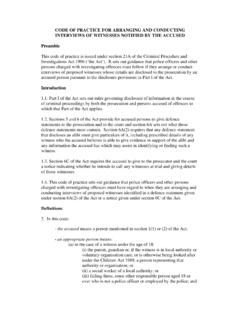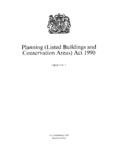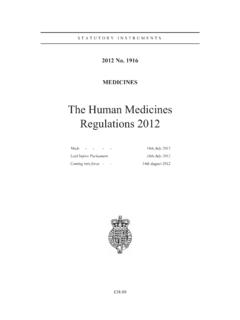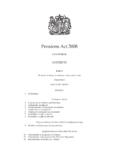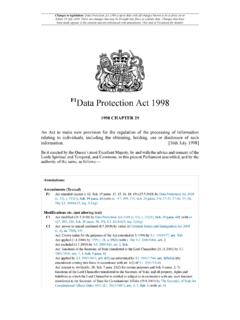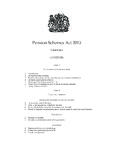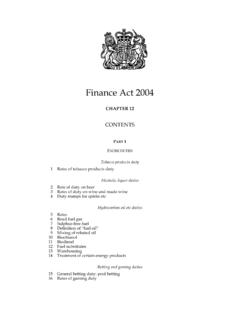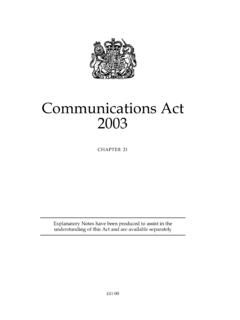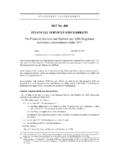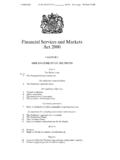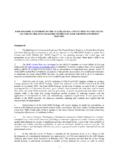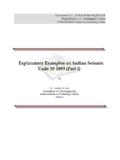Transcription of EXPLANATORY NOTES Water Act 2014 - Legislation.gov.uk
1 EXPLANATORY NOTESW ater Act 2014 Chapter 21 NOTES relate to the Water Act 2014 (c. 21) which received Royal Assent on 14 May 2014 1 Water ACT 2014 EXPLANATORY NOTES INTRODUCTION 1. These EXPLANATORY NOTES relate to the Water Act 2014 which received Royal Assent on 14 May 2014. They have been prepared by the Department for Environment, Food and Rural Affairs in order to assist the reader in understanding the Act. They do not form part of the Act and have not been endorsed by Parliament. 2. The NOTES need to be read in conjunction with the Act. They are not, and are not meant to be, a comprehensive description of the Act. So where a section or part of a section does not seem to require any explanation or comment, none is given. SUMMARY AND BACKGROUND 3. The Water Act will enable the Government to implement proposals set out in Water for Life Cm 8230 (the Water White Paper ) published by the Government on 8 December 2011.
2 The Bill was published in draft (Cm 8375) on 10 July 2012 for pre-legislative scrutiny by the Environment, Food and Rural Affairs Select Committee. Their report was published on 1 February 2013 (HC 674) and the Government s response (Cm 8643) was published on 27 June alongside the Bill. 4. In the main, the Act amends the Water Industry Act 1991 ( the WIA ), but also introduces changes to other legislation. The Act consists of six Parts, 95 sections and 12 Schedules. Below is a brief summary. Part 1: Water industry Chapter 1: Water supply licences and sewerage licences (sections 1 to 7 and Schedules 1 to 5) 5. This Chapter focuses on expansion of the Water supply licensing (WSL) regime, introduction of sewerage licences and the creation of a cross-border retail market between England and Wales and Scotland. 6. The Act amends the WIA by expanding and revising the current WSL regime and adding a sewerage licensing regime.
3 It also increases choice in the retail market by enabling earlier repeal of the threshold which sets the Water usage limit for when non-household customers can switch supplier. This will allow all business, charity and public sector customers to choose their Water and sewerage supplier for the first time, and enable multi-site operators to tender for one supplier across Great Britain. These NOTES relate to the Water Act 2014 (c. 21) which received Royal Assent on 14 May 2014 2 7. To facilitate a cross-border retail market between England and Wales and Scotland the Act amends the WIA and equivalent Scots Law. This will allow Ofwat and the Water Industry Commission for Scotland (WICS) to accept a single application for Water and sewerage licences in each jurisdiction. Chapter 2: Water and sewerage undertakers (sections 8 to 21) 8. This Chapter focuses on arrangements between undertakers and the duties of Ofwat and the Competition and Markets Authority (CMA).
4 It sets out new powers for the Secretary of State and the Welsh Ministers to issue guidance and for Ofwat to issue charging rules with respect to undertakers charges schemes, connection charges, and charges for bulk supplies of Water (and connections for sewerage) between undertakers. This Chapter also makes constructing and operating sustainable drainage systems a specific function of sewerage undertakers. 9. The Government wants to increase the interconnectivity between undertakers so that Water resources can be used more flexibly and efficiently. Therefore the Act amends the WIA to introduce codes and charging rules from Ofwat that are intended to increase transparency and streamline negotiations between undertakers, including those involving new appointees, for bulk supplies of Water . These provisions are mirrored in main connections for undertakers sewerage systems.
5 10. The current special merger regime within the WIA acts as a disincentive to mergers between undertakers and creates uncertainty when a merger is proposed or has taken place. Therefore the Act amends the WIA to allow the CMA to determine whether or not to make a merger reference, or to accept undertakings to compensate for the loss of a comparator in lieu of a reference. The Act also amends the WIA to include a new duty on the CMA to keep the merger turnover threshold under review (currently set at an annual turnover of 10 million where the acquiring undertaker, the target undertaker or both undertakers together meet or exceed this threshold). 11. The WIA requires Water and sewerage undertakers to agree charging schemes with Ofwat prior to charging their customers. This is generally seen to be an overly burdensome and regulatory approach requiring significant concentration of resources each year.
6 Therefore the Act repeals this duty and replaces it with a power for Ofwat to produce charging rules with which the companies must comply in setting their charges schemes and a power for Ministers to issue charging guidance to Ofwat which will shape their charging rules. Alongside this, the Act also allows for the creation of a new charging scheme for developers and other customers connecting to Water and sewerage infrastructure. 12. The Act also amends the WIA to confirm undertakers have the power to construct, maintain and operate drainage systems. These NOTES relate to the Water Act 2014 (c. 21) which received Royal Assent on 14 May 2014 3 Chapter 3: Regulation of the Water industry (sections 22 to 41 and Schedule 6) 13. This Chapter focuses on the regulation of the Water industry (general duties on Ofwat and regulation of relevant undertakers, Water supply licensees and sewerage licensees), interim duties for Water supply and sewerage services in the case of market exit by a licensee, appeals of codes, adjudication functions and the charging powers of the Drinking Water Inspectorate (DWI).
7 14. Sections 22 to 24 amend the general duties with respect to the Water industry. These apply to the Secretary of State, the Welsh Ministers and Ofwat. There is a new primary duty to secure the long-term resilience of Water supply and sewerage systems with particular reference to managing the impacts of environmental pressures, population growth and changes in consumer behaviour. There is also a new duty to secure that undertakers do not show undue preference or undue discrimination in their dealings with other undertakers and licensees. In addition, the Act creates a new power allowing for the production of a statement of the Government s strategic priorities and objectives for Ofwat to follow when carrying out its statutory functions. 15. To support these reforms, the Act provides Ofwat with powers to regulate the Water and sewerage market as competition develops.
8 16. There is also a measure to reduce the frequency with which undertakers are required to produce drought plans to a maximum five-yearly cycle. This will help reduce the administrative burden on Water undertakers and bring the drought plans cycle in line with that for Water Resource Management Plans. If necessary, the Secretary of State or the Welsh Ministers can compel Water undertakers to prepare a drought plan more frequently. 17. The Act includes a measure that amends the WIA to allow the Secretary of State to make regulations for appeals to the CMA against a decision of Ofwat to revise a designated code or not to make a revision following consultation about a proposed revision. There is also a power for the Secretary of State to specify alternative parties to perform some of Ofwat s adjudication responsibilities. This is intended to enable disputes to be resolved in a timely matter.
9 18. There is also an amendment to the WIA to enable the DWI to charge fees for the cost of its regulatory activities beyond 2017. This replaces a similar power in the Public Bodies Act 2011. This will also enable the DWI to adjust its fees and is in line with Government policy that businesses which benefit from regulation should bear the costs, not the taxpayer. Chapter 4: Retail exit: non-household premises (sections 42 to 53) 19. This Chapter provides the Secretary of State with powers to put in place regulations which would permit undertakers, with the consent of the Secretary of State, to stop providing any retail services to current and future non-household customers in their appointment areas. These services will then be provided by one or more retail licensees. These NOTES relate to the Water Act 2014 (c. 21) which received Royal Assent on 14 May 2014 4 Chapter 5: Miscellaneous (sections 54 to 56 and Schedule 7) 20.
10 This Chapter contains two sections that create powers to modify undertakers terms of appointment and licensees licences. The first enables provision to be made about consumer redress schemes. The second allows Ofwat, for a limited time, to make changes to undertakers conditions of appointments and licensed Water suppliers licence conditions in order to implement the Act s reforms. Alongside this there is a power for the Secretary of State and the Welsh Ministers to veto any proposed changes. 21. Section 56 introduces Schedule 7 to the Act, which covers the amendments that are consequential on the provision made by Part 1 of the Act. Part 2: Water resources (sections 57 to 60) 22. This Part of the Act focuses on Water resources and includes provision for reporting on progress on Water abstraction reform in England, withdrawal of compensation for undertakers, main river maps in England and Wales, and Environment Agency maps of waterworks.
